Home harvest apples
The fresher the fruit, the crunchier, sweeter, and more nutritious it is. We have known for at least ten thousand years that the best way to eat an apple is straight from the tree - apples are deeply entwined in human history, art and mythology. Somewhere along the way, the apples that grew in the wild gave rise to the popular eating apple, Malus domestica, we all know today.
Apples first came to New Zealand with the missionary Samuel Marsden in 1819. Our dynamic pip fruit industry has become a world leader with its superior fruit exports, research and development. Apples are now our third biggest export fruit after grapes and kiwifruit. New Zealand bred apple varieties are world famous.
It is our climates and soils that make New Zealand one of the best places in the world to grow apples and pears. While they are grown throughout the country, Hawkes Bay, Nelson, and Central Otago are our top apple regions.
Apples thrive in rich well drained soils where there are cool winters for winter chilling followed by warm springs and ample summer sun, ideally during a dry summer. Pests and diseases are more difficult to control when the growing season is wet.
Apples old and new
There are many thousands of Malus domestica varieties available today; only a select few are considered worthy of mass production. As growers responded to market trends the number of varieties grown in commercial orchards has fallen dramatically over the years.
Leading varieties fill orchards and supermarket shelves but home gardeners need not be driven to what sells best on supermarket shelves, travels well and produces the highest yield per hectare. There is a much wider choice of varieties to enjoy when you grow your own. Among those who know that the tastiest cooking apple or the one that grows on the most disease resistant tree is not always the shiniest, there is rising interest in rekindling old and rare varieties.
Rescued from a very old tree in the Manawatu and now available in garden centres, Monty’s Surprise is hardy and versatile. The large late ripening fruit, pale green with a red stripe, is beautiful for cooking and found to be very high in health-boosting antioxidants. Another old favourite, ‘Bramley’s Seedling’ was developed for lighter free-draining soils and is great keeper, ripening mid to late season. The aromatic ‘Belle de Boskoop', has russeted skin that’s not so eye-catching on modern shop shelves, but this heritage apple is well known for its firm crisp texture and full, tart flavour. It will keep for 3-4 months and gets sweeter with storage.
Orchard favourites that have been surpassed for export but still deservedly popular are sweet Golden Delicious and beloved tart Granny Smith with its bright shiny green skin. Granny Smith is one of the best for cooking and keeps well. Also, it is self-fertile and an excellent pollinator for other apple varieties. Granny Smith originated from a chance seedling in Australia in 1868.
Originating in 1977, New Zealand’s own Royal Gala holds its place as our number one export apple by volume. It is regarded as one of the words best and is a very popular garden apple too. Pretty to look at and sweet to eat, it is ready for picking early in the harvest season, by mid-February. Royal Gala first arose as a sport (random shoot) of the original Gala apple, bred in Greytown in the 1930’s from a seedling of a cross between a Golden Delicious and a Kidd's Orange Red.
A good selection of sought after apple varieties is available in leading garden centres. For those keen to search further afield, there is a daunting array of heritage varieties to explore.
FUN FACT: Apples are currently the fourth most popular fruit in the world, after tomatoes, bananas and watermelons.
Planning and planting
Taking the time to decide which apple trees to plant in a home garden is well worth the effort as trees will ideally grace your garden for decades. First, consider your climate. In a marginal climate outside major apple growing regions some varieties will be more suitable than others. Talking to local gardeners and garden centre staff is a great place to start.
Consider which traits you care most about. Flavour? Disease resistance? Fruit size? Harvest time? Yield? Do you want apples mainly for cooking or eating fresh or both? If a long storage life is important, the late harvest apples generally have very good keeping qualities.
How tall do you want your tree to grow? Very dwarf trees can be harvested without a ladder. While some varieties are naturally compact growing, the potential height of any apple tree is influenced by the rootstock it is grafted onto.
Pollination is another important thing to check, when deciding which apple varieties to plant, especially if you only want to plant one or two trees. Some popular varieties, including Royal Gala, Golden Delicious, Bramley’s and Granny Smith, are self-fertile but most are not. For trees that need cross pollination, failure to fruit happens if there is not a compatible pollinator tree within bees’ flying distance. The wide range of pollinator options and other very useful information can be found on the Waimea Nurseries website, www.waimeanurseries.co.nz.
Plant your apple trees where there is plenty of sun and fertile well-drained soil. If the sunniest spot is along a fence, consider espaliering. To grow apples in a tight space, look to ultra dwarf trees or tall and narrow columnar apples. Avoid areas where the water puddles and don’t plant too close to larger trees. If you have good sun but poor soil, look to dwarf apples for tubs.
Five ways to grow apples in a small garden
- Dwarf trees
A dwarf fruit tree is a small tree that bears loads of normal sized fruit. Some, such as ’Blush Babe ’ , are small because a compact growth habit is in their genes. Also, size is restricted when a tree is grafted onto a special ‘dwarfing ’ rootstock. - Super slim
Ballerina apple trees are tall and narrow with masses of apples born on very short branches close to the main trunk. A great way to the most of vertical space, they ’re easy to care for and require almost no pruning and ideal for growing in containers. - Double and triple grafted
When there is space for only one tree, there is the option to have two or three different varieties all on one tree. Triple or double grafted varieties are available from garden centres. These specially grafted trees have compatible varieties that grow happily together on one tree, without one outcompeting the other. - Grow a ‘family’ tree
Plant three or four different apple trees of similar vigour very close together in one big planting hole. Choose trees on same rootstock. Train them as if they were a single tree with an open centre to let the sun in. The roots of your trees will knit together as they grow, anchoring the family tree strongly in the soil. Fruit will be ready to pick over a longer period rather than a glut. - Espalier
Grow fruit trees in a two-dimensional space along a sturdy wire frame or against a wall. Creating and maintaining an espalier requires more training and pruning than a regular tree, but it ’s very satisfying if you have the time. The ‘stepover ’ is a variation on espaliering whereby apples are trained as a low fence, traditionally as a border to a vegetable garden.
Understanding rootstocks
Apple trees grown from seed are not the same as their parent plant. Most don’t perform well ‘on their own roots’ either. Those that do grow well from cuttings usually become very large trees. For these reasons apple trees are grown by grafting or budding the ‘scion’ wood of the desired variety onto the roots of another variety, known as a ‘rootstock’.
Rootstocks help to control tree vigour and size, which is very useful when growing trees in a defined space. Rootstocks also influence other qualities like fruit quality and disease resistance. The right rootstock can be the difference between a healthy or not so healthy tree.
The M9 dwarfing rootstock keeps trees at a height of 2 to 3m. M27 is even smaller. Generally, the more dwarfing the rootstock, the younger the tree will be when it starts to produce fruit and the larger its fruit will be. On the downside, some kind of support structure is commonly needed as these trees have shallower root systems, and also means more watering is needed in dry periods.
Trees grown on semi-dwarfing rootstocks (such as MM106 or MM116) require temporary staking in the first few years of establishment. Averaging around 4.5m tall, they fruit a bit later in life but generally will fare better in heavy soils than trees on M9 dwarf rootstock.
The old Northern Spy rootstock and its offspring MM793 are more vigorous (non-dwarfing) rootstocks best able to tolerate heavy clay soils. Column shaped apples (for example Ballerina apples) are grown on M793 rootstock, but their very compact genetics counteracts the vigour of the rootstock, keeping columnar trees under 4m tall.
Most apple trees sold in garden centres currently are on M9 or MM106 rootstocks. The rootstock should be stated on the tree’s label.
How to grow apples
- Choose the right spot. Plant your apple tree where it gets as much sun as possible and in good well-drained soil. Avoid areas where the water puddles and don’t plant too close to larger trees.
- Choose the right variety. Invest time choosing the varieties to suit your needs.
- Plant with care. Dig a planting hole that is twice as wide, but the same depth as the root ball of your new tree. Add some slow-release fertiliser and position your tree in the centre of the hole then carefully replace the soil, firming it down as you go. Water thoroughly and add a layer of mulch.
- Stake at planting time to avoid damaging the tree later. Most young apple trees need support while they get their roots established, particularly if exposed to wind.
- Water young trees. Some watering will be needed in the first few summers to ensure the soil doesn ’t become dry, as water stressed trees will grow poorly and produce less fruit.
- Prune in winter. Prune apple trees in winter to improve light penetration and air movement. Remove damaged weak and crossing branches. For more information go to Waimea Nurseries waimeanurseries.co.nz
TOP TIPS
- Copper fungicide prevents fungal diseases on apple trees. Spray in autumn and again in spring, before and after blossom. Clear leaf litter from under trees to reduce overwintering disease spores.
- To trap overwintering codling moths wrap corrugated cardboard around tree trunks then remove and destroy in August.
Bakers’ favourites
While any apple can be used in a cake or dessert the best apples for cooking are not the super sweet crisp varieties designed for eating raw. Favourite cooking apples include:
- Granny Smith - for tartness and depth of flavour that holds its shape well when cooked.
- Ballarat - for intense flavour and a light, fluffy texture when cooked, it’s one of the best for crumbles or shortcakes.
- Belle de Boskoop - another great crumble and sauce apple with a rich tangy flavour.
- Bramley’s seedling - one of the most loved cooking apples, it’ light and fluffy when cooked and good for baking whole.
- Braeburn - a shiny red skinned apple that holds its shape when cooked and is good for baking whole.
- Ballerina Waltz - a great tangy cooking apple to grow in a narrow space.
- Sturmer Pippin - a great cooking apple and a favourite for cider.

29-Feb-2024
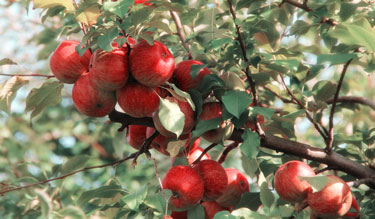
Ready to pick fresh from the tree
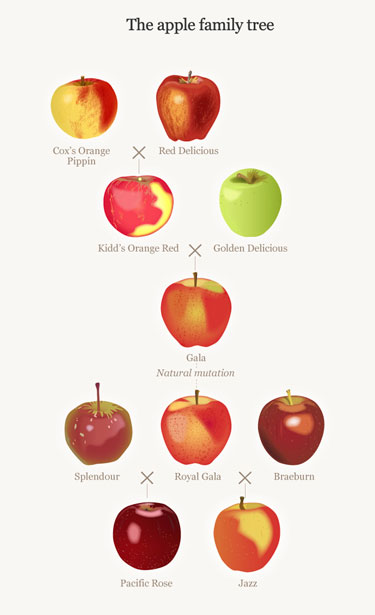

Columnar apple 'Scarlet Sprite'
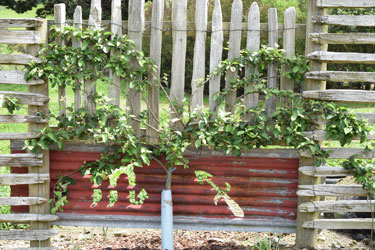
Espalier apple

Fresh apples, great to eat for '5+ a day'
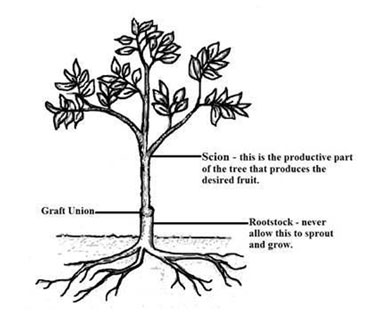
A grafted apple tree
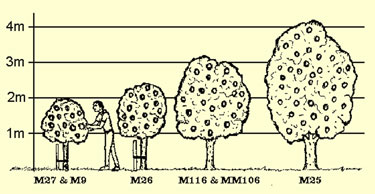
Apple rootstock sizes

